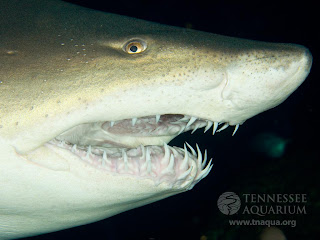Name: Sand Tiger Shark (A.K.A. Sand Tiger, Sand Shark, Grey Nurse Shark, Spotted Ragged Tooth Shark, or Blue-Nurse Sand Tiger)
Scientific Name: Carcharias taurus
Length: Between 9 and 11 feet
Weight: About 350 pounds
Sand Tigers are most commonly found on the sandy beaches of North America (hence the name "Sand" Tiger). These sharks are grey with reddish-brown spots on their backs. They have sharp, pointy heads and their bodies are bulky. They're teeth are very jagged (as seen below; also giving them the nickname of the "Spotted Ragged Tooth Shark").
Sand Tiger Sharks are commonly found with a disease that causes their backs to become very arched. This disease causes the Sand Tigers so much pain they are usually put on pain killers or they may be put down. No one knows why this happens or what causes it, but biologists are working on finding out more information and a cure for the disease.
Sand Tigers are night feeders, similar to most other sharks. They are also the only sharks known to gulp air and keep it in their stomach to help them keep their near-neutral buoyancy. This helps them while they're hunting. Sand Tigers never hunt alone. They are always traveling in schools.
People are usually scared of this type of shark because of their teeth and the fact that they're sharks. But truth is, no matter how close to humans they may come, they don't really pose a threat.
There have only been 29 reported attacks on humans by a Sand Tiger, however, only two were fatal. The reason for some of these attacks have been because of spear fishing. They're commonly found in a close proximity to where spear fishers hunt.
The Sand Tiger Sharks have the lowest reproduction rate of all species of sharks. They give birth to few pups because of the unborn cannibalistic nature of them when they're inside the stomach still. The shark pups usually end up being about 3 feet long.
That's my knowledge of Sand Tiger Sharks. Hope you enjoyed :)
Image(s)courtesy of www.sharkwallpapers.net and www.tnaqua.org


I LOVE THIS SHARK! I love how it is so different from other sharks and the color on it's back; It makes the shark look so... pretty, in lack of a beter term. I feel bad for these sharks because most of them have a disease that makes them go through so much pain. :(
ReplyDelete-K.C